So you are in search of Japanese knives and want to buy one for your kitchen. However, you might be thinking what makes the Japanese knives so durable and how do they hold their durability and sharpness for a lifetime?
Instead of dying from curiosity, you should find the reasons for this to understand why Japanese knives and Japanese Cleavers are so promising and long-lasting. During Medieval Imperial Japan, the Japanese knives were made out of katana steel blades.
Nowadays, AUS10 and VG10 have mainly replaced those steels. To find the perfect steel, you need to get clarity between AUS10 VS VG10 steel. Now, these are not the only pieces of steel that traditional manufacturers are using.
Instead, there is a whole lot of other Best Japanese Steel that composes a perfect blade, with added stability & sharpness. But they mainly include VG & AUS steels. Both of these belong steel to one family & you should know a bit about them.
Before diving deeply into the Best Japanese Steel list or the AUS10 VS VG10 comparison, you should understand some theory of it. So you can have a clear and better understanding of your purchase.
Understanding the Best Japanese Steel for Knives
Alright, so all of us know the origin of steel. Any steel that you see around you is mainly extracted through iron ore. Instead, it’s better to say that steel is a perfect alloy of iron. Every steel is formed through an alloying process.
To form steel, they revise its chemical structure metallurgically by adding carbon within the iron. This addition ranges from 0.1% to up to 3% as well. But, this all depends on our ideal case. For knives, the ratio is somewhere less than 2%.
Mainly, the blade or culinary steels are divided into high carbon and stainless steel. Both of these steels are also known as alloy steel and a little bit of modification in their elements renames them for another feature.
Once a significant ratio of carbon is added to steel, it becomes carbon steel. If you add a bit more carbon content into it, this becomes high carbon steel then. Adding non-ferrous materials like chromium, vanadium, nickel, or molybdenum to carbon steel makes it stainless.
Technically the carbon steel knives are durable, hard, and easy to sharpen. But at the same time, they are not very rust-resistant. You will have to properly take care of these knives; otherwise, they will rust and lose their sharpness.
Stainless steel knives deliver the sharpest, durable, & one of the most resilient blades that doesn’t rust. However, they are not so easy to sharpen unless you are a master or perfectly know machine sharpening at least.
The addition of carbon in the steel projects its durability, hardness, resilience, or its ability against rusting. This also affects their hardness in terms of the Rockwell scale and this is further divided into other groups of culinary steels.
Types of Best Japanese Steel
- White steel

When adding a little bit of unique but non-ferrous elements within the carbon steel, the steel becomes less impure. And it is considered durable or rust-resistant depending upon the existing carbon content.
Now, the white steel is also divided into two subgroups; and they are known as “White No.1”, and the “White No. 2”. Usually, the “White No. 1” steel consists of a high carbon ratio compared to the White No. 2.
The first steel is harder than the second one and it also holds the edge for a long time. Not just is it hard, it is also sharp at the same time. The No.2 steel has medium hardness and its Rockwell score is also less than 61HRC.
However, the white steel can chip easily as it cannot afford a sudden jerk or impact due to the high carbon content in its structure. To support this, some Japanese knife brands add some other non-ferrous content.
- Blue Steel
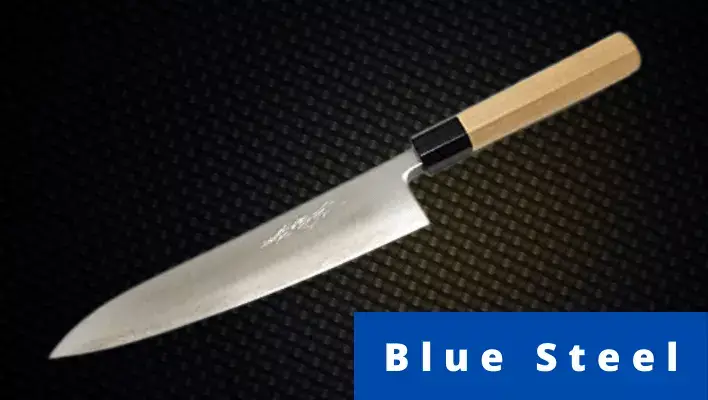
Blue steel is the most durable and popular form of culinary steels and it is widely used in premium Japanese knives. Just by adding tungsten and nickel along with the chromium within the steel makes you a blue steel.
Now, the super steels particularly belong to this family as you will get a steel composition with vanadium, molybdenum, and sometimes cobalt too. The knives made through hand-forging or in traditional ways use this sort of steel core.
The Blue steel family knives are outstanding in almost every part and factor that you consider in a knife. These blades are sharpest, provide the best edge, offer optimal hardness, and they don’t chip so easily.
With these blades, the steel core can get an extensive hardness of up to 65 HRC. However, the Shun knives that use these steels and more specifically VG-10 can surprisingly deliver a Rockwell hardness of up to 68 to 70HRC even.
The Best Japanese Steels for Knives
Alright, so if you have taken a look at the complete classification of Japanese steels, this is the time to dive deeper into the exclusive details of blade steels. From here, we will show you the most popular, and the best steels for knives that you can easily find in most brands available out there in the market.
Instead of explaining each single steel type to you, we have directly compared the best ones out of those. It will also help you to digest perfectly, and it will also save you some time.
Check out the Types of knives Steel
Comparison of Best Japanese Steels
- AUS10 VS VG10
AUS 10 steel
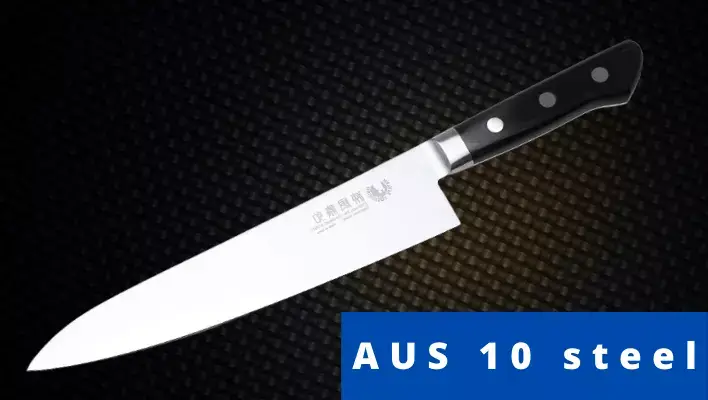
AUS 10 steel is one of the most common steels that you can find almost in every local or non-premium Japanese knife manufacturer for a reasonable price. It is almost similar to VG10 steel, but there are some differences too that we will discuss very soon.
This Japanese steel is one of the most popular stainless steel which is quite delicate. It provides you a sharp edge that is enough for cutting veggies.
AUS 10 steel is one of the resilient materials and it is also known as a super steel. But VG-10 was earlier known as the super steel before AUS-10. This steel has a fairly medium carbon content, and it could be around 1% to 1.5% as well.
Together with carbon, it also contains non-ferrous elements like molybdenum, cobalt, vanadium, and chromium. The chromium could be at least 10% of the structure and other guys can no longer exceed 2% of the overall structure.
AUS 10 steel hardness could be up to 60HRC but it fluctuates between 58 to 61 HRC as well. This steel also comes in other models, whose hardness and quality vary from use to use.
VG10 Steel
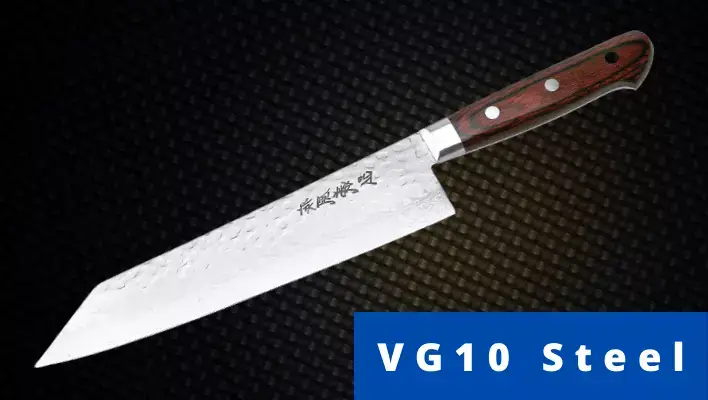
VG10 steel is one of the most premium steel in Japanese culinary products. This high-quality stainless steel is hard and unbreakable; and delivers one of the best edge retentions in the market.
Usually, professional Japanese knife users or professional chefs opt for the knives made through VG10. It gives an aggressive and balanced feel that ultimately produces accurate cuts. The cuts are exclusively the sharpest ones.
VG-10 is an upgrade to its parent steel, known as VG-1. This most popular Japanese steel delivers ultimate sharpness, durability, and exclusive retention which helps in keeping the edge.
VG10 steel hardness is somewhere above 60HRC and it can also go up to 63HRC in some cases depending on the treatment. Some brands like Tojiro and Shun also use this steel. The rust-resistant comes built-in with the VG 10 steel.
Due to the addition of common & non-ferrous alloys, the blade has now become easier to sharpen. So now it is easy to sharpen and it also keeps its sharpness for a long time.
As compared to AUS10, the VG10 is a more versatile, durable, sharp, and rust-resistant steel. This steel is some sort of premium, and professional, which has increased its price a little bit more than AUS-10.
- AUS 8 VS VG10
AUS 8 steel
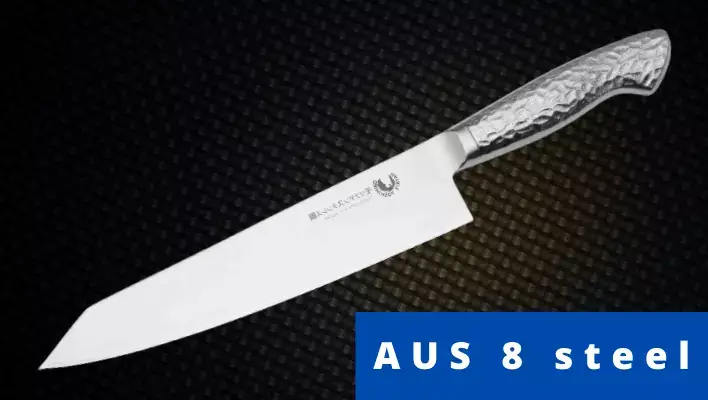
AUS 8 is mid-range Japanese steel, which is not so popular nowadays. But you can still get these blades with Mercer’s, Famcute, or Mac’s culinary and even in some of the Dalstrong’s series. Practically, this steel is mid-range in almost every case.
This delivers sharp cuts mostly in veggies and fruits sort of ingredients, but it is not that greatest as VG-10 or AUS-10 steel. However, it has a beauty that doesn’t require a lot of maintenance.
AUS-8 steel is also pretty easy to sharp, and it also keeps its sharpness for more than average time. This steel belongs to the stainless steel family and it also resists corrosion, stains, and rust.
In this steel, you will get a composition of carbon for no more than 1% of the composition. Along with this, it also owns up to 13% of chromium to make it rust-resistant, some silicon, and less than 0.5% of molybdenum and nickel.
AUS 8 steel hardness is no more than 60 HRC, but you will commonly get 58HRC knives. You can easily find this steel in the casual and inexpensive category of knives. It is a good choice for casual and inter chefs by the way.
When comparing AUS 8 VS VG10, you can easily get in advance that VG-10 wins most of the parts. VG-10 is a premium steel that has high Rockwell hardness, cobalt, and non-ferrous addition to bring extensive longevity.
- VG 10 vs VG 1
VG1 Steel
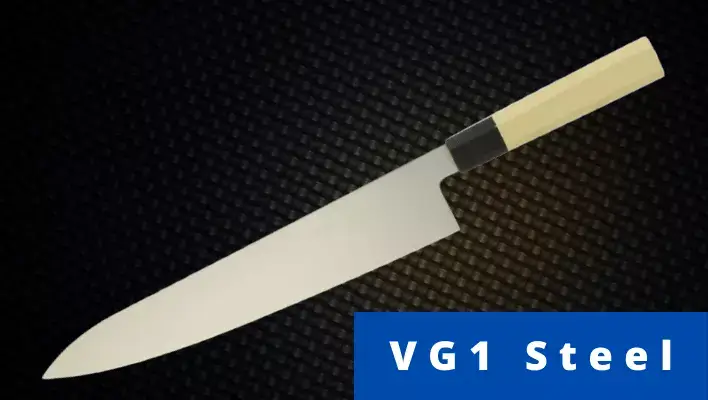
Alright, now we have got you with the VG-1 steel which is the predecessor of VG-10 steel. This amazing steel has almost the same quality as its little boy. It was one of the most popular boys of all time before the invention of the VG-10.
The first difference that you will get between these is their production procedure. Still, this steel is used in Japanese kitchen knives but you still have a better option in terms of sharpness, durability, and deliverance as well.
Due to the addition of cobalt and nickel, VG-10 has taken the place of its father. But this steel still owns the same decent stability and versatility.
VG1 steel hardness is somewhere 58-59HRC on the Rockwell scale which makes it mid-range steel for now. This has almost or maybe less than 1% of carbon content, about 13% of vanadium, and some sort of nickel as well.
- AUS-10v VS VG10
AUS-10v steel
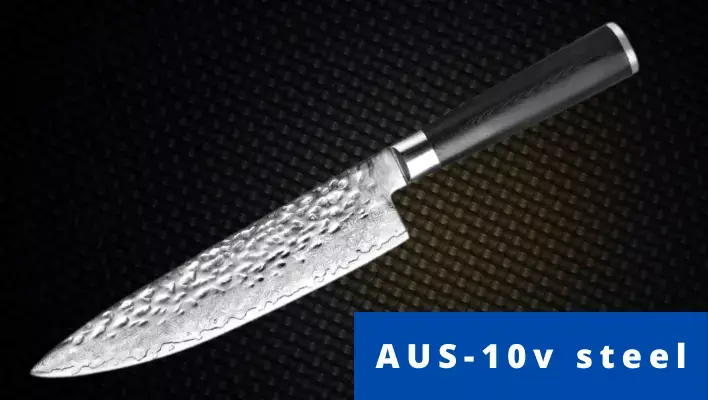
AUS-10v steel belongs to the AUS-10 family, and you will hardly find it anywhere except for Dalstrong’s knives. There is not a significant difference between AUS-10v and the actual one, but for production technique.
This steel is made through forging and it is mostly manual work. After completing the forging part, this steel is heat-treated through a Vacuum which makes it hard. In this technique, a vacuum heat chamber for the furnace comes into play and partially cooled down at different temperatures gradually.
AUS-10v steel hardness is almost 58HRC and depending on the quality, it can be up to 60 HRC but not more than that. It is still rust-resistant and has a sharp blade that also delivers a decent edge.
However, VG-10 is still the king in front of AUS-10v and it is unbeatable. AUS-10v is not that hard as the VG series but it truly delivers enough that you can use it fluently. You can find AUS-10v knives in the mid-range segment.
Summing Up the AUS10 VS VG10 Comparison
A good and the best Japanese knife is made through good steel out of the box. They are equally good for everything from cutting vegetables to filleting fish. Using good steel in the core blade of any knife makes it versatile, durable, razor-sharp, and extensively provides you a long-lasting edge.
Before purchasing a Japanese knife you should understand its core structure and in most cases, these knives are your lifetime companion. Depending upon the steel type and heat treatment your knife could become superior in performance.
Now, whatever is your job nature and environment, you should opt for a matching blade to get the most out of its value for money. If you are a butcher and opted for a premium blade knife, it is not a wise choice then.
To get the best sharpness, the super steel knives from blue steels are unbeatable then. VG-10 is recommended if you want sharpness and rust-resistant blades at the same time. The rest elements such as versatility & durability are packed in both cases, and you don’t need to worry as such.